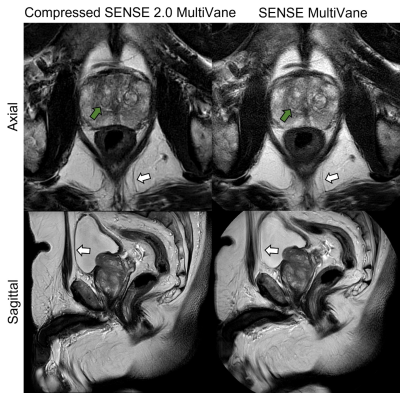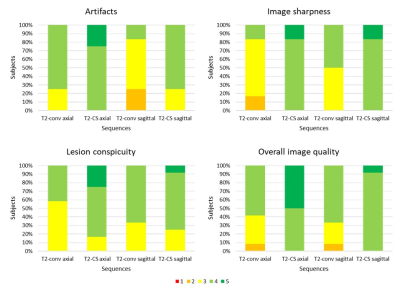1619
Fast and motion robust 2D T2 TSE Propeller acquisition of the prostate with Compressed SENSE: comparison with conventional SENSE acquisition1Department of Diagnostic and Interventional Radiology, University Hospital Bonn, Bonn, Germany, 2Philips GmbH Market DACH, Hamburg, Germany
Synopsis
Multiparametric MRI (mpMRI) of the prostate can detect clinically significant prostate cancer in men. To accelerate the time-consuming acquisition process, we integrated a new Compressed SENSE (CS) method for T2-weighted sequences with propeller acquisition and compared it qualitatively and quantitatively to conventional SENSE accelerated T2-weighted propeller sequences. We could demonstrate that while the new CS acquisition method has less artifacts, better image sharpness and higher apparent signal-to-noise ratio (aSNR) and contrast-to-noise ratio (CNR), it reduced the acquisition time by 24%. These findings indicate a superiority over the conventional T2-sequence and could improve the diagnostic workup of patients with prostate cancer.
Introduction
Prostate cancer has the second highest incidence and fifth highest mortality among all cancer types in men1. Early diagnosis is therefore crucial for the survival of affected patients. In recent years multiparametric MRI (mpMRI) of the prostate has shown an immense potential to solve this challenge, as it can detect small significant lesions non-invasively and is therefore the basis for a targeted biopsy of the prostate2. Indications for mpMRI will further increase in the future. Additionally, the number of affected patients will rise due to the aging population. Therefore, as the throughput of prostate mpMRIs will increase, it is important to further accelerate MRI protocols while ensuring a high diagnostic quality1,2. The aim of this prospective study was therefore to evaluate whether a new compressed SENSE (CS) method for T2-weighted propeller acquisitions could achieve these high-quality standards while reducing the scan time in comparison to conventional T2-weighted propeller sequences.Material and Methods
The institutional review committee approved this prospective study and all subjects gave written consent prior to mpMRI. This prospective study included individuals with suspected prostate cancer after either clinical examination (digital rectal exam, DRE) and/or due to elevated prostate-specific-antigen (PSA) of >4 ng/ml. All scans were performed on the same 3 Tesla MRI (Philips Ingenia Elition X). The scan protocol included T1-weighted, diffusion-weighted and a standard parallel imaging (SENSE) accelerated T2-weighted (T2w) sequence with propeller acquisition (MultiVane XD), henceforth named conventional T2-sequences (T2conv). Additionally, a CS accelerated T2w sequence with propeller acquisition (CS 2.0 MultiVane XD) was included in the scan protocol, henceforth named Compressed SENSE sequence (T2CS). In comparison to the T2conv, it used incoherent sparse sampling and the wavelet transformation for the iterative reconstruction of the images3,4. In each subject axial and sagittal planes were acquired. The T2w images were blinded and qualitatively and quantitatively compared. For the qualitative comparison the parameters artifacts, image-sharpness, lesion conspicuity and overall image quality were rated for each sequence on a scale from 1 (low quality) to 5 (high quality) by two radiologists (with 1 and 9 years of experience in prostate mpMRI, respectively). For quantitative comparisons, apparent signal-to-noise ratio (aSNR: SIperipheral zone/SDmuscle) and contrast-to-noise ratio (CNR: (SIfat-SImuscle)/SDmuscle) were calculated. PI-RADS scores were assessed separately for both sequences5. Statistical analysis of the qualitative features was conducted using the paired Wilcoxon signed-rank test, while for the quantitative features a paired t test was used. The weighted Cohen´s Kappa was calculated to assess the degree of matched ratings between the two radiologists. A P value of <0.05 was considered indicative of a significant difference.Results
A total of 12 subjects were included in this ongoing study. Mean age of patients was 66±9 years (range: 51-80 years). The T2CS had significantly less artifacts (axial: 4.3±0.5 vs. 3.8±0.5, P=0.05; sagittal: 3.8±0.5 vs. 2.9±0.7, P=0.01) and a better image-sharpness (axial: 4.2±0.4 vs. 3.0±0.6, P=0.005; sagittal: 4.2±0.4 vs. 3.5±0.5, P=0.01) compared to the T2conv (see Figure 1). The difference in lesion conspicuity was comparable in the axial plane (4.0±0.7 vs. 3.4±0.5, P=0.05) and in the sagittal plane (3.8±0.6 vs. 3.3±0.5, P>0.2). Overall image quality was significantly better in the T2CS in the axial plane (4.5±0.5 vs. 3.5±0.7, P=0.01), but not significantly in the sagittal plane (4.1±0.3 vs. 3.5±0.7, P=0.1) as shown in Figure 2. The weighted Cohen´s Kappa was 0.44 with a moderate agreement between the raters. Quantitative analysis showed a higher aSNR in the T2CS (54.8±10.2 vs. 31.7±5.0, P<0.0001) and a higher CNR (58.7±3.4 vs. 31.2±3.1, P<0.0001). The scan-time was reduced for the image acquisition in the axial plane from 232±5s to 172±3s (P<0.0001), which equates to a reduction by 26%. In the sagittal plane scan-time reduction was similar with a decrease from 217±11s to 164±5s (P<0.0001), which is a reduction by 24%. For all subjects the final PI-RADS-scores were the same for both the T2conv -sequence and the T2CS.Discussion
Compared to standard T2w prostate imaging, the evaluated new compressed SENSE accelerated T2w sequence with propeller acquisitions had a significantly higher image quality in most of the assessed categories, while drastically reducing the acquisition time. Especially artifacts were reduced, while the overall image-sharpness improved. Most importantly, there was no difference between the calculated PI-RADS-scores, as this score is the basis for any further diagnostics, e.g. invasive biopsy of the prostate2. It should be noted that for the calculation of the PI-RADS-score the DWI-sequence is also needed, which was the same for all scans5. Further analysis on a larger patient collective must be conducted to assess the full potential for replacing the T2conv -sequence completely.Conclusion
The evaluated CS-accelerated T2w sequence with propeller acquisition is superior to the conventional used sequence while significantly reducing the acquisition time. The scan time reduction can be efficiently used for increasing the overall number of scanned patients, which in turn could improve the diagnostic workup of patients with suspected prostate cancer. In addition, this technique can be used much more generally for MRI scans of all organs, as T2w sequences are nearly always acquired and thereby are able to drastically increase the availability of motion robust and fast MRI scans for the general population.Acknowledgements
N/AReferences
1. Sung H, Ferlay J, Siegel RL, et al. Global Cancer Statistics 2020: GLOBOCAN Estimates of Incidence and Mortality Worldwide for 36 Cancers in 185 Countries. CA Cancer J Clin 2021; 71(3):209-249. DOI: 10.3322/caac.21660. Epub 2021 Feb 4. PMID: 33538338.
2. Martin E, Fredrik J, Andrea D, et al. MRI-Targeted or Standard Biopsy in Prostate Cancer Screening. N Engl J Med 2021; 385:908-920, DOI: 10.1056/NEJMoa2100852
3. Chang Y, Pipe JG, Karis JP, Gibbs WN, Zwart NR, Schär M. The effects of SENSE on PROPELLER imaging. Magn Reson Med 2015; 74(6):1598-608. DOI: 10.1002/mrm.25557. Epub 2014 Dec 17. PMID: 25522132.
4. Pipe JG, Gibbs WN, Li Z, Karis JP, Schar M, Zwart NR. Revised motion estimation algorithm for PROPELLER MRI. Magn Reson Med 2014;72(2):430-7. DOI: 10.1002/mrm.24929. Epub 2013 Sep 4. PMID: 24006354.
5. ACR, ESUR and AdMeTech Foundation. Prostate Imaging Reporting & Data System (PI-RADS). 2019.
Figures

